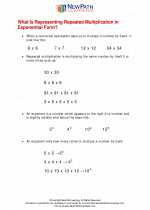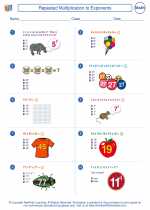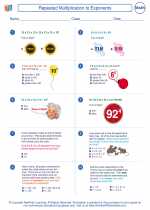Repeated Multiplication to Exponents -> exponents
Exponents
Exponents are a way of representing repeated multiplication. They consist of a base number raised to the power of an exponent. For example, in the expression 2^3, 2 is the base and 3 is the exponent. This means that 2 is multiplied by itself 3 times.
Rules of Exponents
1. Multiplying Powers with the Same Base: When multiplying powers with the same base, add the exponents. For example, 2^3 * 2^4 = 2^(3+4) = 2^7.
2. Dividing Powers with the Same Base: When dividing powers with the same base, subtract the exponents. For example, 2^5 / 2^2 = 2^(5-2) = 2^3.
3. Power of a Power: When a power is raised to another exponent, multiply the exponents. For example, (2^3)^4 = 2^(3*4) = 2^12.
4. Negative Exponents: A negative exponent indicates the reciprocal of the base raised to the positive exponent. For example, 2^-3 = 1 / 2^3 = 1/8.
Practice Problems
1. Calculate 3^4 * 3^2.
Answer: 3^4 * 3^2 = 3^(4+2) = 3^6.
2. Simplify (5^2)^3.
Answer: (5^2)^3 = 5^(2*3) = 5^6.
3. Evaluate 4^-2.
Answer: 4^-2 = 1 / 4^2 = 1/16.
Conclusion
Exponents are a powerful tool in mathematics, allowing for efficient representation of repeated multiplication. By understanding the rules of exponents and practicing various problems, you can master this concept and apply it to solve real-world problems.
[Exponents] Related Worksheets and Study Guides:
.◂Math Worksheets and Study Guides Sixth Grade. Repeated Multiplication to Exponents

 Worksheet/Answer key
Worksheet/Answer key
 Worksheet/Answer key
Worksheet/Answer key
 Worksheet/Answer key
Worksheet/Answer key
